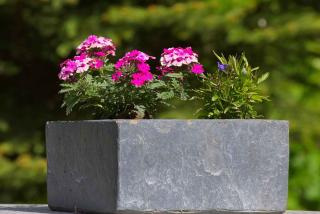

Garden verbena, or landscaping vervain, is a simply beautiful flower and will be a perfect match for gardens and container-based growing alike.
Facts about garden verbena
Name – Verbena x hybrida
Family – Verbenaceae
Type – perennial or annual
Height – 12 to 40 inches (30 to 100 cm)
Exposure – full sun
Soil – light, well-drained
Flowering – from June to September
 From planting and care and from spring to winter, follow our gardening tips to increase blooming.
From planting and care and from spring to winter, follow our gardening tips to increase blooming.
Plant your garden verbena preferably in fall, but you can also plant it until spring as long as it doesn’t freeze.
 You can start your covered sowing early in March and April or directly in the ground starting from mid-May.
You can start your covered sowing early in March and April or directly in the ground starting from mid-May.
Verbena x hybrida, although it’s a perennial, is grown as an annual.
 Vervain is a plant that requires rather little care but some attention must be given in order to extend the blooming for a while.
Vervain is a plant that requires rather little care but some attention must be given in order to extend the blooming for a while.
After the first fall frost spells, you can pull your garden vervain out; the following year’s blooming will be insignificant.
Since it is vulnerable to aphid attacks, read up on how to treat against aphids if need be.
 This perennial plant which is grown as an annual counts many different varieties (over 200).
This perennial plant which is grown as an annual counts many different varieties (over 200).
These plants are mostly ornamental and aren’t used for infusions, even though they’re all edible. Usually, medicinal or lemon verbena are used for infusions or herbal tea.
Lemon verbena (Aloysia triphylla, Aloysia citriodora) is the species most used by herbal tea manufacturers.
Garden verbena bears flowers that range from pinkish white to violet, with touches of blue and red depending on the variety.
You can plant them along edges, in flower beds and they’ll also look great in garden boxes or hanging pot arrangements.
Plant some near your vegetable patch since it repels caterpillar-causing white butterflies.